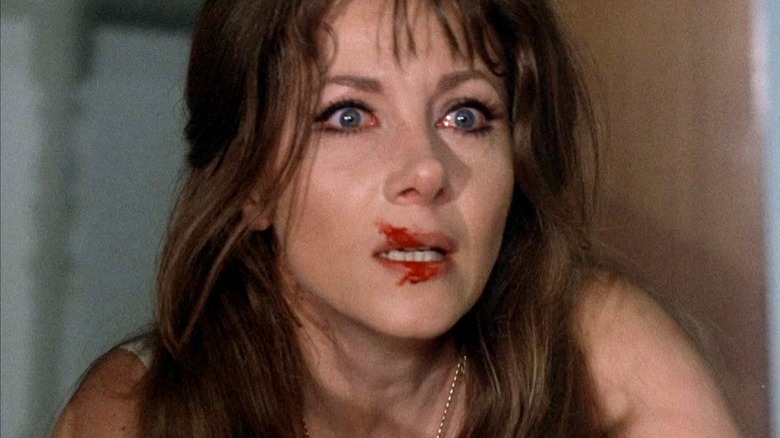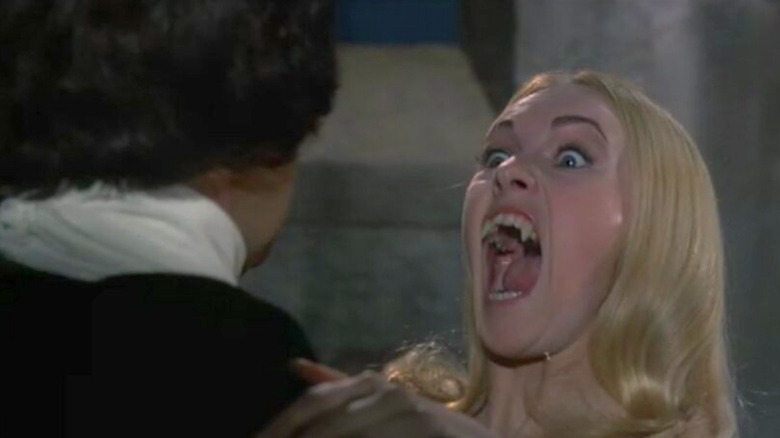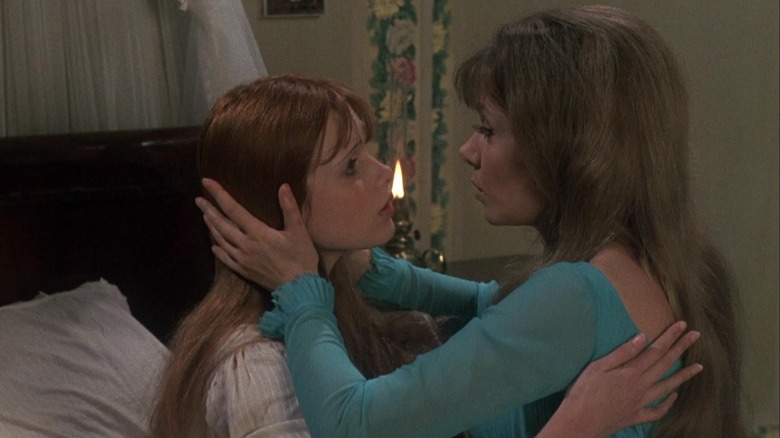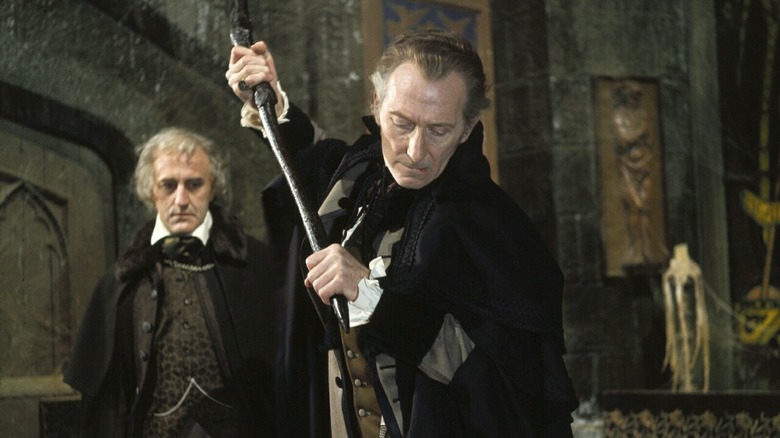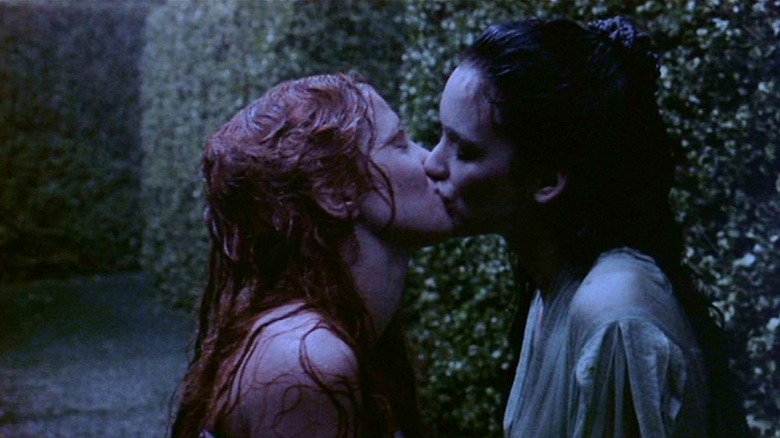Year Of The Vampire: The Vampire Lovers Brought Sexy Back To Bloodsucker Lore
We may receive a commission on purchases made from links.
Scream Factory's brand new Blu-ray edition of "The Vampire Lovers," featuring a sparkling (but not sparkly, take that "Twilight") new 4K transfer along with a killer Kim Newman interview, seemed like as good an excuse as any to dive back into this perennial favorite. The 1970 feature is more than just a titillating exploitation vehicle, but served as a historical turning point for both Hammer Studios and the horror genre itself. It also introduced a genre icon in the form of Polish beauty Ingrid Pitt, who cemented her legendary status with a performance that is at once uninhibited, frightening, and shockingly emotionally nuanced.
With a rock-solid director, sterling cast, and gorgeous gothic production value, "The Vampire Lovers" is ripe for greater awareness as we celebrate the centennial of the vampire in cinema.
What It Brought to the Genre
Based on Irish author Sheridan Le Fanu's 1872 novella "Carmilla," which beat Bram Stoker to the punch by nearly three decades, "The Vampire Lovers" tells the story of an Austrian General named Spielsdorf (Peter Cushing), whose daughter falls ill and dies after making "close friends" with a supposed countess' daughter named Marcilla (Ingrid Pitt). Sensing something is quite off about the circumstances of his daughter's death, Spielsdorf leaves to find the famed vampire hunter Baron Hartog (Douglas Wilmer). Meanwhile, the same daughter of the countess worms her way into the life of a new well-off family under the name "Carmilla," making vampiric advances under the guise of seduction towards young Emma (Madeline Smith) as well as her governess Mademoiselle Perrodot (Kate O'Mara). When Spielsdorf finally returns with Hartog, it may be too late for dear, sweet, innocent Emma...
By 1970 Britain's famed Hammer Studios had been in the technicolor gore business since 1957, having kicked off their gothic horror tear with period pictures like "The Curse of Frankenstein" and "Horror of Dracula." Where the sight of blood, heaving bosoms, and staked body cavities was once considered salacious, by the turn of the '70s this atmospheric gothic fare had become as traditional a part of English moviegoing as the Marvel heroes are for us today. Hammer's monsters had somehow been reframed as classy family entertainment when compared to more explicit product like Jean Rollin's "The Rape of the Vampire," Roman Polanski's "Rosemary's Baby," or George Romero's "Night of the Living Dead," all released in 1968. Under directive from studio head James Carreras, Hammer decided it would take another stab at sensationalism by upping the violence quotient and, for the first time, adding lots of explicit nudity into the mix for "The Vampire Lovers."
Vampyros Lesbos
Pairing with U.S. B-movie kings American International Pictures, who had made a mint with their own string of Roger Corman productions based on Edgar Allan Poe stories, Hammer set about securing two key talents to bring about this new era of horror. The first was director Roy Ward Baker, who up until then had been known for traditional dramas like the Titanic movie "A Night to Remember." Having previously made the extraterrestrial thriller "Quatermass and the Pit," black comedy "The Anniversary," and cheeky sci-fi flick "Moon Zero Two" for Hammer, Baker would lend an assured hand to what was anything but a sure thing for the studio known for its horror fare.
They also recruited their leading lady Ingrid Pitt, fresh off a featured role opposite Richard Burton and Clint Eastwood in the World War II film "Where Eagles Dare." While Pitt was seemingly handicapped in that she was much older than the character she was meant to be playing (a press release listed her age as 25, but she was actually 32), and also could not hide a blatant Polish accent, the actress managed to use both to her advantage. Her slightly older appearance goes along with the fact that Marcilla/Carmilla/Mircalla Karnstein is meant to be an immortal vampire, and the accent gives her an otherworldly quality not dissimilar to that of Bela Lugosi's own particular brand of Hungarian elocution. She also clearly had no qualms with being naked onscreen or sharing erotic scenes with fellow actresses Smith and O'Mara, which would have been quite eye-opening to a public that had been used to heavy censorship of lesbian themes before this. Pitt felt little embarrassment as she actually enjoyed people admiring her figure.
Those physical assets were only part of the package, though, as Pitt gives a stunning performance containing multitudes of layers. At times it is hard to tell whether the wistful expressiveness of Carmilla's eyes is displaying true longing for Emma, or if she merely sees all those around her as food. The way her character is able to use a breadth of different approaches to different people from her grab bag of manipulation (for the sole purpose of devouring) is fascinating to watch. She sometimes projects innocence, and other times appears worldly beyond her years ... or anyone's years, for that matter. It's such a sophisticated approach to a cinematic vampire that Pitt manages to carry "The Vampire Lovers" almost entirely on her own shoulders. It also must be said that it is, perhaps, possible the way Carmilla claims to be averse to funerals and anything macabre — preferring the hedonistic pleasures of life — is a reflection of actress Pitt's own personal feelings after having survived the Stutthof concentration camp during World War II.
A Killer Cast
Ingrid Pitt is not the only bright star among the cast of "The Vampire Lovers," as the film is packed with several heavy hitters from the U.K. including, but not limited to, Peter Cushing. The "Star Wars" legend had altogether appeared in 22 of Hammer's horror pictures over the course of his career, most notably as — alternately — Doctor Frankenstein and Doctor Van Helsing in the Frankenstein and Dracula pictures. Although Cushing's appearance is only at the bookends of this film, he would have a much larger role as a tyrannical witch-hunting Puritan in the third film of Hammer's Karnstein Trilogy, "Twins of Evil."
Another bright light in the cast is Jon Finch in his film debut. The powerful Finch had an auspicious first few years in the business leading Roman Polanski's "Macbeth" and Alfred Hitchcock's "Frenzy" back-to-back before health concerns waylaid his career, including having to abdicate his original role in "Alien" to John Hurt. The presence of established British actors like George Cole ("Cleopatra") and Douglas Wilmer ("Octopussy") lend an air of legitimacy to what could have been pure exploitation, while director Roy Ward Baker gives us the same lush gothic visuals of fog-shrouded forests and cobwebbed castles audiences had come to expect from the earlier, "classier" Hammer films.
Although "The Vampire Lovers" would be Hammer's only pairing with AIP, and their last American-financed film altogether, it proved successful enough to warrant two sequels in the Karnstein cycle, both released in 1971: "Lust for a Vampire" (also available from Scream Factory) and "Twins of Evil." Baker also went on to helm several more horror pictures for Hammer, including "Scars of Dracula" (1970), "Dr. Jekyll and Sister Hyde" (1971) and "The Legend of the 7 Golden Vampires" (1974). There was also no turning back from this film, as henceforth almost all Hammer productions went heavy on the T&A. While the Dracula movies starring Christopher Lee would trudge along for a few more years (themselves becoming equally explicit), the Karnstein Trilogy allowed the studio to produce a new bloodsucker franchise sans Lee, all while propelling Ingrid Pitt who — unlike Lee in the Dracula films — was quite comfortable with the extensive dialogue she was given, and absolutely made a meal of it.
Setting a Sexy Precedent
While the lesbian aspects of the "Carmilla" story were completely expunged from Carl Dreyer's nearly-silent 1932 adaptation "Vampyr," they were explored much more directly in Roger Vadim's French-Italian 1960 co-production "Et mourir de plaisir," which was released in the U.K. and U.S. markets as "Blood and Roses" with 14 minutes of more daring material lopped off. Another Euro-horror version in black and white titled "Crypt of the Vampire" starring Christopher Lee was released in 1963 and is relatively tame, although well worth the watch on Severin's "The Eurocrypt of Christopher Lee" collection.
It took "The Vampire Lovers" and its potent combination of explicit nudity and sexuality paired with the sumptuous production values of Hammer to usher in a bold new era exploring the true subtext of all vampire lore. The act of any vampire, male or female, penetrating their victim and draining them of life force has always had an inherently sexual overtone. A decade later Susan Sarandon and Catherine Deneuve would take this aspect of vampirism and run with it for Tony Scott's sumptuous "The Hunger," where Deneuve's heavy accent and predatory manner echo Ingrid Pitt to the extreme. A decade after that, Francis Ford Coppola would carry all the gothic elements of the Hammer pictures into his big budget blockbuster "Bram Stoker's Dracula," by which point scenes of lesbianism and graphic beheadings had become downright mainstream. Carmilla's part in the "Castlevania" video games and animated series have solidified that. It all leads back to the big leap that Hammer took on a movie that deserves a proper place in the pantheon of classic horror.
